The Web3 gaming revolution has begun and is set to revolutionize everything.
You’ve definitely heard the buzz, but what does they imply for you as a gamer?
It’s more than just fancy new tech jargon; it’s a whole new universe of gaming possibilities that will shock your head.
The Web3 gaming platform is at the forefront of this shift, transforming the industry by using blockchain technology, hence introducing decentralization and digital ownership. The Web3 gaming business is predicted to reach $312 billion by 2027, with an annual growth rate of 2.8% from 2026.
This transition is more than just graphical upgrades; it is a fundamental shift in game production, play, and ownership, with blockchain technology and Non-Fungible Tokens (NFTs) opening up new options for both gamers and developers. This hunger is also seen in the fast-increasing market capitalization of gaming-related cryptocurrencies. Today, the Web3 game platform ranks in the top 20 categories by market capitalization.
This article will look at how Web3 games are transforming the gaming environment, how gaming has had a huge influence on the growth and creation of Web3 technologies, and what exciting possibilities exist for the future.
Unveiling Web3 Gaming: A New Era of Earning Income
Think about entering two unique game worlds: one based on traditional play, the other on technological advancement and decentralization.
In the first world, Web2 gaming is dominant. In this case, owning in-game riches is really an illusion. Consider “Clash of Clans,” in which participants establish empires and accumulate resources, yet everything is under the game developer’s custody. Consider renting a wonderful castle: pleasant but ultimately temporary.

Now, turn your sight to the perspective, where play to earn web3 games await in a region packed with possibilities. Blockchain technology, a digital record that serves as a sign of transparency and ownership, has transformed the environment in this instance. Imagine “Axie Infinity,” in which lovely pets known as Axies are NFTs. Players breed, train, and sell Axies, each with its own indisputable deed engraved into the blockchain. You carry more than simply a weapon; you control your digital destiny.
In “Clash of Clans,” your empire is limited to the game’s preset pathways, and game developers manage the economy. In contrast, “Axie Infinity” provides blockchain gaming infrastructure solutions in which ownership extends beyond pixels. Players influence economies and strategy, with Axies exchanged directly between adventurers.
Furthermore, with Web3, collaborative effort is essential. Consider “Decentraland,” a virtual realm in which users may create, purchase, and trade NFT-based assets. The community’s creativity creates each virtual setting, from bustling towns to quiet retreats—a collaborative creation.

In summary, Web3 gaming infrastructure is more than just escapism; it is a frontier where digital sovereignty meets limitless creativity. Players are more than simply explorers; they are masters of their own fate.
Key Features of Web3 Games
Centralized platforms dominated Web2 gaming, with game creators in charge of assets and progress. Players purchased virtual things but only licensed them, which limited their creative flexibility and income prospects. Web3 gaming reshaped this with games like CryptoKitties and Decentraland, which used blockchain gaming infrastructure providers to enable actual asset ownership and decentralized economies. This move unleashed unrivaled creativity and empowered players, converting game experiences into dynamic, player-driven environments. Here’s how creativity and player experience have evolved:
Ownership and Creativity: In Web2 games, developers own the assets, which limits player involvement. In contrast, Web3 keeps in-game assets as NFTs on a blockchain, providing users with verifiable ownership. This move encourages inventiveness, allowing gamers to trade and develop their digital assets like never before.
Player-Driven Economies: In Web2 games, creators hold the wallet, and characters, determining cost and availability. However, in Web3, participants take the initiative, venturing into decentralized markets where they may freely exchange assets using cryptocurrency. This move promotes creativity and player-driven economies.
Community and Collaboration: In the Web3 game design platform, community involvement is essential. Through decentralized governance, creators work directly with players, allowing for community-driven decisions that impact game development in a transparent and inclusive manner, with player feedback driving the game’s progress.
Incentives for Participation: Web3 games give more than merely fun; they also provide real incentives like cryptocurrency rewards, tokens, or NFTs in exchange for gaming successes and community efforts. This gamification is in direct contrast to Web2’s restricted reward mechanisms.
Diverse Game Experiences: Web3 gaming pioneered play-to-earn and play-to-yield features, which reward players for their achievements and efforts. This innovation stands in stark contrast to Web2’s traditional strategy, ushering in a wide range of gaming genres, from virtual worlds to competitive multiplayer experiences.
Play-to-Earn: Gaming with Financial Rewards
Imagine yourself right now playing your favorite game, having fun, and dominating the leaderboards. When you’re finished, convert the coins you earned into real funds, go to the grocery store, and grab some food!
That’s the excitement of a play-to-earn (P2E) game. These games provide players with real-world currency or in-game assets like tokens, virtual lands, skins, or NFTs, all of which have substantial market worth.
They want to give back to the community. With pay-to-play game models are out the door, you can finally enjoy p2e games and earn tangible benefits. P2E games are blockchain-based and work similarly to Bitcoin, and this area is becoming increasingly popular. According to recent Statista research, by 2026, at least 25% of individuals around the world would spend at least one hour per day in the metaverse, with 30% of global firms predicted to have metaverse-ready projects and services.
The design and mechanics of the game determine how you earn cryptocurrency while playing it. Here are some typical methods:
- Trading in-game tokens obtained via accomplishments or as a reward for other cryptocurrencies or fiat money on exchanges and marketplaces.
- Collecting and selling NFTs representing unique game goods or characters.
- Participating in governance and community activities connected to game development and design.
- Competing in in-game tournaments using coins or NFTs as rewards.
- Building on virtual pieces of land in a metaverse while charging entry.
- Participating in staking or yield farming activities can also help you earn cryptocurrency by improving the security or liquidity of blockchain networks.
True Ownership: Redefining Digital Assets
Players were thriving in the vivid environment of free play-to-earn games, where they could explore and discover new things. Unlike traditional games, where assets were just data held by developers, earn to play was founded on Web3’s innovative concepts, assuring actual ownership of in-game assets.
Let’s discuss the story of ,
Sarah, a seasoned fighter, ventured on a mission on Alien World, a Web3 gaming platform, and discovered a unique artifact: “the Sword of Eternity.” In a traditional game, this sword would be bound to her account and subject to the whims of game producers. However, in Alien World, the sword was a one-of-a-kind NFT (Non-Fungible token) stored on the blockchain, granting Sarah undisputed possession. She may trade it on decentralized marketplaces, lend it to others, or even sell it for cryptocurrency, all while maintaining its provenance and worth. In traditional games, her prized weapons could be lost if the game shut down or if she was banned.
Meanwhile, across space, Jack invested in virtual land in Alien World. This property, which had its own NFT, allowed Jack to develop, modify, and commercialize as he saw fit. He built an inn where other players could relax and trade, generating passive money from their visits.
Alien World’s Integration with Play-to-Earn The Web3 platform also ensured that all decisions, transactions, and interactions were visible and safe, thanks to smart contracts. This decentralized model not only empowered users like Sarah and Jack but also created a dynamic, player-driven economy that changed how people interacted with the digital world.
DeFi’s Role: Unlocking Financial Opportunities
Decentralized Finance (DeFi) is revolutionizing the gaming industry by offering financial processes that go beyond traditional game borders. In Web2 games like Temple Run, players earn in-game assets and money, but these items are only available in the game and have no real-world value. DeFi solves this by allowing genuine ownership and utility of in-game assets, opening up new revenue opportunities for gamers.
Temple Run: Coins Without Real-world Value
In Temple Run, players gather cash while traveling dangerous passageways and avoiding threats. Within the game, you may use these coins to buy power-ups or character improvements. However, their utility ends there, as they offer no real-world value or investment opportunities. Players cannot commercialize their in-game achievements outside of the Temple Run ecosystem.
The Sandbox: A Staking Platform for Passive Income
Contrast this with The Sandbox, a Web3 game that uses DeFi to create a more dynamic and financially rewarding setting. In The Sandbox, participants own virtual land and assets in the form of NFTs (Non-Fungible Tokens) that may be purchased, sold, or exchanged on decentralized marketplaces. Beyond conventional ownership, The Sandbox introduces the notion of staking, which allows users to lock up their in-game assets and receive passive income.
DeFi in games offer,
Staking
Imagine John, a player in The Sandbox, who owns a prime piece of virtual land where she’s built a bustling marketplace. She decides to stake this land in a DeFi protocol within the game. By doing so, she contributes to the game’s ecosystem and earns rewards in the form of SAND tokens, the game’s native cryptocurrency. These tokens can be reinvested in the game for upgrades, traded with other players, or converted into other cryptocurrencies.
Liquidity Pools and Yield Farming
In The Sandbox, DeFi integration enables liquidity mining and yield farming. Players collect assets into decentralized pools, allowing for smooth trade within the game while receiving returns on their contributions. This is similar to real-world DeFi but in a virtual gaming environment, improving wealth-building prospects and economic participation beyond traditional gameplay mechanisms.
Ownership and interoperability
Players in The Sandbox hold NFTs of virtual lands on the blockchain, which are transferable between platforms. Beyond games, this ownership allows for profitable purchases, sales, and leasing. Staking these NFTs in DeFi protocols inside The Sandbox generates passive revenue in game-specific cryptocurrency or governance tokens, which enhances player engagement and financial strategy.
Conclusion
As traditional Web2 gaming diminishes, the advent of Web3 begins, propelled by DeFi integration and the pioneering gamefi staking platform. Players are no longer limited to isolated game economies; they now have genuine ownership of virtual assets, which they may stake for passive income and participate in lively, linked ecosystems.
The best defi staking platform offers unique ways to tackle obstacles, such as seamless liquidity provision, yield farming, and asset interoperability across many platforms. This dramatic move not only increases player autonomy and financial prospects but also ushers in a new era in which gaming transcends entertainment and becomes a dynamic hub of innovation and wealth creation.




